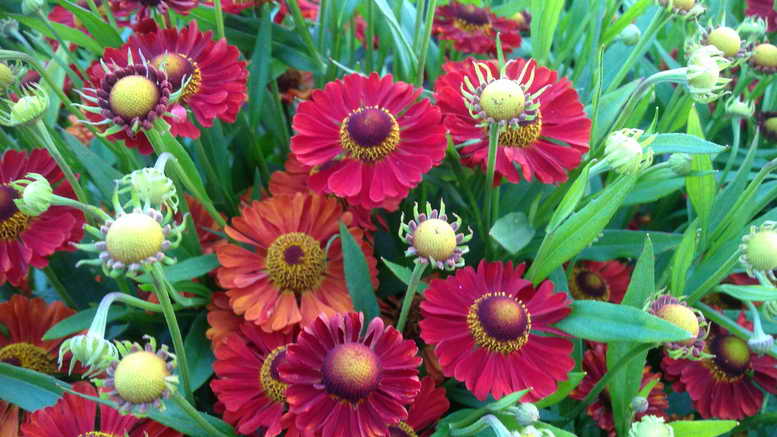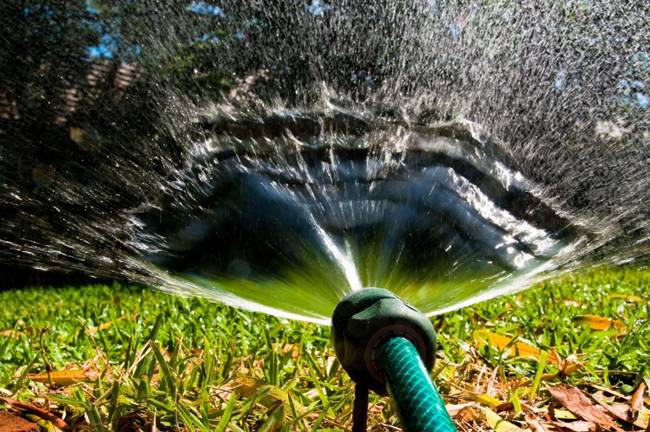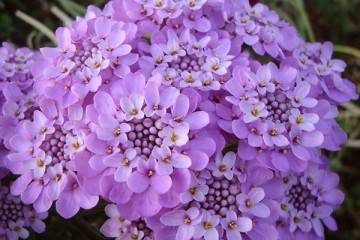Gelenium perennial - planting and care in the garden
Content:
Perennial Helenium is a herb that is often used in horticulture. Shoots grow up to 2 m and can bloom all summer. The culture has large flowers of different shades: yellow, red, orange. They decorate the garden area and go well with other plants.
Description of gelenium: varieties and varieties
The plant was first bred in the United States. Today there are more than 30 types of culture.
Peduncles dry out with the arrival of frost along with the root system. However, during their withering away, living buds that appear on the aboveground part of the culture form a rosette. It includes leaves and roots. It is the new rosette that creates the flowering stem for the next year.
Before planting a culture, it is worth studying its description. Perennial is characterized by straight stems, which branch out from above. Lanceolate leaves are arranged in a regular order and form inflorescences in the form of baskets. They can be solitary or form corymbose plants. After flowering, cylindrical achenes appear, covered with fluff.
Many types of culture are known today. Gardeners most often prefer these varieties:
- Bigelow. Shoots reach a height of 80 cm. The leaves are straight, lanceolate. Flowering begins in June-July. The flowers are yellow-orange in color and reach 5 cm in diameter. The central part of the flower is brown;
- Gupesa. The plant is considered to be very popular. It is characterized by dense lignified shoots reaching 1.5 m in height. The leaves are green and lanceolate. The flowers reach 3-5 cm in diameter and are distinguished by a red-yellow tint. Flowering lasts 2 months;
- helenium is autumn. He is considered the founder of many varieties of culture. It reaches 2 m in height and has dense stems. The culture is decorated with bright orange flowers. They are covered with a yellow border and red lines;
- helenium hybrid. The culture reaches 1-1.3 m in height. The varieties differ in different shades: from light yellow to rich burgundy. They reach 3 cm in diameter. Abundant flowering occurs in July;
- Chuppah. This culture grows well in rocky terrain. The helenium chuppah is characterized by stems 60-70 cm high.Above are bright yellow inflorescences with a diameter of 10 cm.
Most of the crop varieties are derived from the autumn variety. Hybrid and variegated crops can hardly stand the cold.
The most popular plant varieties include the following:
- Moorheim Beauty. The plant reaches a height of 90-120 cm. A characteristic feature is considered to be flowering in the form of rosettes of different shades - red, yellow, orange. The culture blooms from July to November;
- Waltraut. This is a hybrid culture that reaches 80 cm. The plant is distinguished by yellow-copper inflorescences. They have a brown center. This helenium blooms in July-August;
- Rubintswerg. This is a cold-resistant culture that reaches 60 cm. For the Rubintswerg helenium, bright red inflorescences are characteristic. Flowering lasts 4 months;
- Canaria.This variety is characterized by golden petals and the same center. The height of Helenium Canaria is 1.5-1.7 m;
- Double Trouble. The culture has yellow petals and a yellow-green center. It reaches 1.7 m in height;
- Helena. The plant can have yellow or reddish-brown hues. In height, it reaches 50-120 cm. Flowering continues until October;
- Bandera. This variety has red inflorescences. Helenium Bandera is characterized by a stem height of 40-50 cm. Flowering lasts until September;
- Salsa. The flowering of the plant lasts from June to the end of September. Gelenium Salsa is characterized by red-orange petals with a brown-golden center;
- Autumn jazz. Plants reach 1.5 m. They can have different color of petals - yellow, orange-red, golden;
- Ranchera. It is a compact plant with a height of 55 cm. For Gelenium Rancher, bright red inflorescences are characteristic. They can also be burgundy;
- Sombrero. The plant is considered unpretentious. Gelenium Sombrero is characterized by bright golden inflorescences and the same middle. Flowering begins in August and lasts until cold weather;
- Poncho. It is an ornamental crop that has bright red double flowers with a yellow border. Helenium Poncho is characterized by a height of 60-80 cm;
- Brassingham Gold. This culture is characterized by yellow inflorescences. The bushes do not exceed 1 m in height;
- Lava. It is a perennial hybrid reaching 95 cm. Small green leaves are characteristic of it. The buds have a red tint;
- Sunrise. This variety has a beautiful burgundy hue. Flowers adorn the garden until early October;
- Phaeton. This plant is characterized by double flowers. They can be yellow or purple;
- Chelsea. The plant is a short bush that has large crimson inflorescences and an apricot-yellow border.
Planting site and soil
In order to achieve full development and lush flowering of perennial helenium, planting culture should be carried out according to the rules.
Seed planting
You can grow flowers by seed. You can collect planting material yourself or buy it.
Before planting, the seed should be soaked in water and left for 2 hours. Then immerse it in a solution of potassium permanganate, then dry it and start planting.
This will require 250 ml containers and soil. It is allowed to use peat cups. Plants can be planted in the ground directly in them, they will easily disintegrate in the soil.
For growing crops, you can buy land in a store or make it yourself. In the second case, it is worth mixing 1 part of sand and peat with 3 parts of humus.
It is worth planting seeds in a large container. To begin with, it should be filled with earth, then spread out the planting material and sprinkle with soil. Cover the top with foil to obtain a greenhouse effect. Then move the pot to a warm place and ventilate periodically. When sprouts appear, the film can be removed. When 2 true leaves appear, the plants are moved to separate containers.
Night frosts are contraindicated for seedlings. If such a threat persists, it is worth planting plants in a more favorable period.
Transplanting
When growing helenium, planting and care in the open field is of great importance. Planting seedlings in open ground should be after the formation of 3-4 true leaves. This usually happens in late May or early June. In this case, it is important that the soil warms up to 10 ° C at a depth of 10 cm.
Planting seedlings in the soil is as follows:
- Make holes on the prepared bed 15 cm deep and 10 cm in diameter.
- Place 2 cm of drainage material on the bottom.
- Pour 200 ml of warm water.
- Move the seedling into the soil.
- Sprinkle with a layer of earth and compact by hand.
- Drizzle with water. It should be warm.
Watering and loosening the soil
In temperate climates, the plant should be watered every week. 2-3 liters of water are consumed for 1 bush. For this, it is worth using settled or spring water. In arid climates, the amount of watering is increased up to 2 times a week. If there is frequent precipitation, it is necessary to moisten the soil less often - once every 2 weeks.
After each watering and rain, the soil should be loosened. It is recommended to remove all weeds during the procedure. They degrade the quality of the soil and absorb minerals. As a result, the soil becomes poor.
Reproduction methods
Culture propagation is carried out in 2 ways - by seeds or by dividing the bush. In the first case, the seeds should be planted for seedlings in March, after which the bushes are moved into open ground. The annual culture does not bloom. The first buds appear in a year.
When a culture is propagated by dividing the bush, the mother plant must be carefully dug out, trying to avoid damaging the roots. After that, with a knife or scissors, the roots should be cut into several parts and planted.
Top dressing and transplanting
You need to feed the helenium flower 3 times during the season. This can be done after planting or the emergence of the first shoots, during flowering, after collecting the seeds and in preparation for the winter season.
In May, it is recommended to use mineral fertilizers that contain a large amount of nitrogen. This substance helps to improve flowering and stimulate the growth and development of crops. Excessive amounts negatively affect the development of culture.
During flowering, mineral compounds should be used, which include copper, potassium, phosphorus. Thanks to them, it is possible to replenish the energy reserves that the culture spends on the formation of buds and flowers.
Seeds appear on the shoots at the end of October. After collecting and pruning, it is worth using complex mineral products that contain phosphorus, potassium, nitrogen. They must be applied dry. During the winter, minerals are absorbed by the soil, and by the spring they get to the plant.
Pests and diseases
Gelenium is resistant to diseases and pests. The main problem of the plant is considered to be viral infections, which lead to deformation of leaves and flowers. Also, the culture may encounter the appearance of gray mold, which provokes damage to the foliage and the death of buds. Infected shoots are recommended to be removed and burned immediately.
To avoid problems, the plant must be periodically inspected and pest control. Most often, snails lead to damage to leaves, shoots and buds. Their natural enemies are lizards, birds, frogs. Therefore, it is worth directing efforts to increase their population.
Also, snails do not like some plants. These include yarrow, wormwood, sage, chamomile. These crops can be planted in Helenium beds.
How to prepare for wintering
For the winter, the shoots of the plant should be cut almost to the ground. No more than 10-15 cm should remain above its surface. After pruning, the bed is covered with mulch. It can consist of moss or sawdust. From above, the site can be covered with lutrasil. This will protect the plant from severe frosts.
Flowering period and care after
Gelenium inflorescences appear gradually. At the same time, some of them fade, while others are in the ovary stage. The wilted flowers should be cut off. This will help form new buds. After flowering, you can collect seeds and cover the crop for the winter.
Use in landscape design
The plant is characterized by lush flowering. Therefore, it is used to decorate flower beds and lawns. The flower can be planted along fences and curbs. It is grown independently or combined with other flowers - asters, phlox, hosts, three-leafed stonecrop.
You can create a complex mixborder, for which it is worth using herbaceous perennials, cereals, ornamental shrubs.
Gelenium is also actively used in floristry. It can be used for bouquets. In this case, you need to choose completely open inflorescences, since the buds do not open in the vase.
Gelenium is a popular ornamental plant that is very popular with gardeners. To achieve good results in its cultivation, it is necessary to strictly follow the rules of agricultural technology and provide the culture with high-quality and complete care.






















